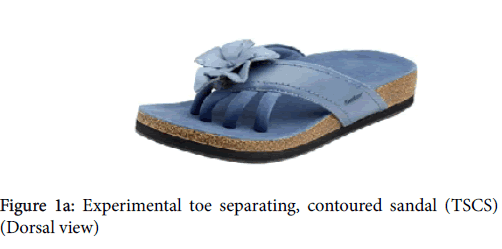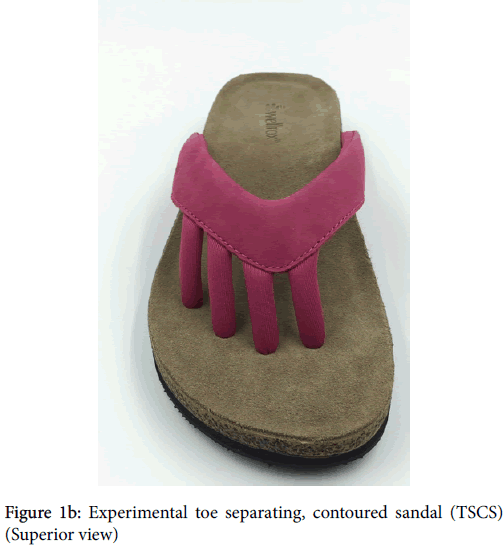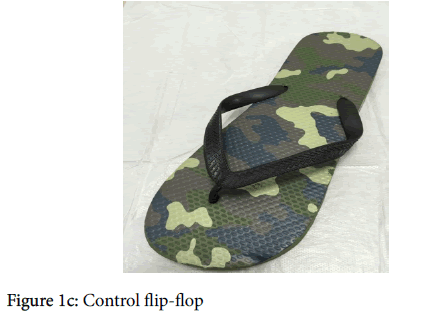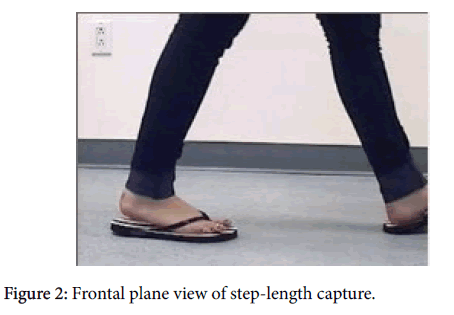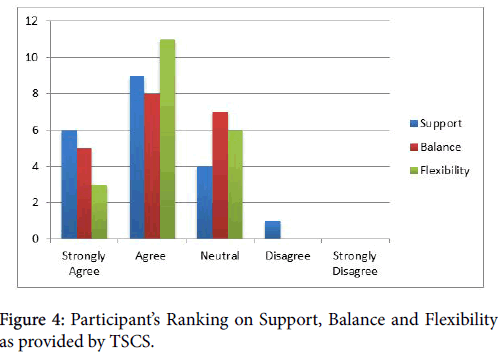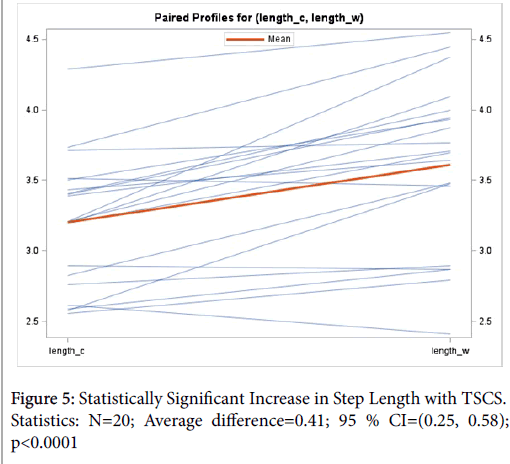Research Article Open Access
Comparative Analysis of User Perception and Step Length Using Toe Separating, Contoured Sandals versus Thong Style Flip-Flops
Jay Emlen1, Loretta Logan1, Michael Huchital1, Amanda Siegel1, Matthew Weintraub1, John T Doucette2 and Peter Barbosa1*1New York College of Podiatric Medicine, New York, United States
2Icahn School of Medicine at Mount Sinai, New York, United States
- *Corresponding Author:
- Peter Barbosa
New York College of Podiatric Medicine
53 East 124th Street
New York, NY 10035, United States
Tel: 2124108476
Fax: 2124100940
E-mail: pbarbosa@nycpm.edu
Received date: October 28, 2016; Accepted date: November 22, 2016; Published date: November 28, 2016
Citation: Emlen J, Logan L, Huchital M, Siegel A, Weintraub M et al. (2016) Comparative Analysis of User Perception and Step Length Using Toe Separating, Contoured Sandals versus Thong Style Flip-Flops. Clin Res Foot Ankle 4:215. doi:10.4172/2329-910X.1000215
Copyright: © 2016 Jay Emlen, et al. This is an open-access article distributed under the terms of the Creative Commons Attribution License, which permits unrestricted use, distribution, and reproduction in any medium, provided the original author and source are credited.
Visit for more related articles at Clinical Research on Foot & Ankle
Abstract
Objective: Traditional thong style flips-flops are a popular form of footwear that is widely accepted in diverse cultures around the world. Several new products have emerged on the market with similar modifications, including padded toe separators in each of the four interdigital spaces and contoured foot beds containing medial arch support and deep heel seats. We examined one of these toe separating, contoured sandals (TSCS) to assess the user perception and biomechanical impact of this new trend of modifications. Twenty subjects participated in this study which examined step length differences and participant satisfaction comparing TSCS to generic thong style flip-flops.
Methods: To access subject satisfaction, 20 volunteer female participants were asked to complete a 21-question user satisfaction survey. Step length was examined using the Pedigait motion capture and video gait analysis system. Step length differences between sandal types were compared using a paired T-test.
Results: Evaluation of the data revealed that subjects reported positive perceptions with respect to stability (97%), support (75%), balance (65%), and flexibility (45%) afforded by the TSCS. The experimental TSCS were associated with a significantly greater average step length than that of the control flip-flop (3.6 vs. 3.2; p<0.0001).
Conclusion: Through subjective (user perceptions) and objective (measured step length events) means it was determined that TSCS provide an improved means of ambulation as compared to traditional thong style flip-flops.
Keywords
MeSH: Shoes; Orthoses; Gait; Locomotion; Walking Non-MeSH: Sandals; Toe-Separator; Flip-Flop; Step-Length; Arch Support
Introduction
Thong style flip-flops have become a very common form of footwear in modern society, with reported rates of use as high as 43% in women [1].
However, minimal support offered by the common flip-flop presents concerns with regard to normal foot biomechanics, maintaining normal gait, overall satisfaction, and comfort.
Previous research has explored the relationship of foot pathologies and the use of thong style flip-flops, which require the wearer to dorsiflex the ankle in order to prevent the sandal from falling off [2].
Criticism of the thong style flip-flops is inherent in the design. The thin rubber soles with uniform thickness frequently associated with traditional flip-flops are just one of the shortcomings responsible for the biomechanical deficit.
Due to lack of support and adaptation through the weight-bearing portion of gait, soles of traditional flip-flops are unable to maintain proper foot biomechanics throughout the gait cycle. This use of out-ofphase musculature can lead to overuse and alteration of normal gait patterns [3].
Sandals lay claim to being both the oldest as well as the most familiar foot covering used throughout the world [4]. One advantage of sandal-wear is the lack of restriction in the transverse (horizontal) plane. In contrast, closed-toe shoes are more likely to constrict the toe box, which has been attributed to several forefoot pathologies [5].
Previous research has found that young adults increase their step length when wearing shoes as compared to walking barefoot [3,6].
Toe separating, contoured sandals (TSCS) are an emerging footwear product composed of four soft fabric loops that are configured to separate the toes.
The material used in the toe separators of the sandal examined in this article is composed of visco-elastic polyurethane foam surrounded by an antimicrobial fabric. The lower element of the sandal is made of either cork or rubber and features a foot bed that has a deep heel pocket and a built-in medial arch support [7].
Dorsal and superior views of the experimental TSCS product are shown in Figures 1a and 1b, the control sandal is shown in Figure 1c.
Currently there are no studies examining the biomechanical effects of TSCS on lower extremity function or user perceptions. The objective of this study was to determine if TSCS provide benefit to its wearers in terms of comfort, perceived stability, and step length measures, as compared to a traditional thong style flip-flop.
Methods
Participants
Female students at the New York College of Podiatric Medicine (NYCPM) were invited to participate in the study via email. Approval to conduct this study was obtained from NYCPM’s Institutional Review Board prior to commencing study recruitment. Inclusion criteria included female subjects between the ages of 20 and 30 that had no known health conditions involving complications of the foot, and no prior foot pathologies. Twenty (20) female students were enrolled into the study by signing the consent form to participate, which described complete details of the study protocol. Subjects were assigned a randomized ID number in order to maintain confidentiality.
Assessment of volunteer shoe size and instructions to volunteer participants
Participants’ weight was obtained using a Health o meter® Professional scale. Each participant had both feet measured using the Brannock Foot Measuring device, which provides an accurate measure for shoe fit and size. Volunteers were allotted one pair of TSCS according to the measured shoe size, and were instructed that the sandal must be worn 15 minutes the first 2 days and 30 minutes the following 2 days. Participants were asked to bring their pair of TSCS to Survey Completion Day on day 5.
Survey completion day
Participants were provided a generic thong style flip-flop matching the size of each respective TSCS. Subjects were instructed to walk the entire length of the room (35 feet) back and forth twice for each research condition: first wearing the control thong style flip-flop, then wearing the experimental TSCS. The participants were then instructed complete a 21-question pilot survey. The survey included basic demographic questions, as well as 21 user perception and satisfaction questions. Participant satisfaction was measured using a Likert scale from “strongly agree” (value of 1) to “strongly disagree” (value of 5). The survey evaluated participants’ opinions on various aspects of the sandal, including comfort, range of motion, grip, balance, flexibility, and overall satisfaction.
Step length analysis
The step length module was conducted in the gait laboratory of NYCPM’s biomechanics research facilities. Participants walked along the gait lab walkway (23 feet long and 6 feet wide), where the motion capturing system recorded their strides with three separate cameras (positioned on the front, back, and side of the walkway). Computer software PediGait® (PEDI Technology PT Inc.) and Fast Stone Image Viewer (FastStone Soft) were used to record and analyze the participant’s gait as seen in Figure 2. Each participant was instructed to walk 45 seconds first wearing the control thong style flip-flop, then another 45 seconds wearing the experimental TSCS. Using the computer software, an average of four screen shots were captured in both the frontal and sagittal planes documenting step length events with the control and experimental conditions. Images were printed on US Letter size paper (8.5-inch by 11-inch), and step length was measured, rounding to the closest millimeter (mm) using ML Tools 6- inch digital caliper. In the sagittal plane, step length was measured from the heel of the advancing foot to the toe of the back foot (to the nearest mm). In the frontal plane, distance from the heel to the wall was measured (to the nearest mm).
Statistical analysis
The step length for each subject was measured multiple times while wearing the experimental sandal and while wearing the control thong style flip-flop. Within-subject means were calculated for each sandal type to get a single step length measurement under each condition to be used for analysis. The mean of these averaged step lengths was then compared between the experimental and control sandals using the paired t test. These within-subject means were based on between 1 and 6 replicate measurements of step length, with 75% of them being based on 3 or more measurements and only one being based on a single measurement. Since averages based on one or two measurements might be more imprecise and have the potential to introduce measurement error, the analysis was repeated using only subjects who had at least 3 step length measurements with each sandal.
Categorical variables are presented using frequencies and percentages. Continuous variables are described using means, standard deviations, and 95% confidence intervals. The paired t test was used to test for differences in mean step length event scores between sandal types. Statistical analyses were performed using SAS version 9.4. Significance was defined by a p value <0.05.
Results
Demographics
Participant demographics are detailed in Table 1.
| Parameter | Mean (n=20) | Range |
| Age | 23.6 year | 21-30 |
| Weight | 133 lbs. | 109-169 |
| Height | 60.8 inches | 53-69 |
| Shoe Size | 7 | 06-08 |
Table 1: Participant Demographics.
Racial identity was as follows: 45% identified as Caucasian, 45% identified as Asian American, 5% identified as African American, and 5% identified as mixed race.
User perception and satisfaction survey results are summarized in table 2
| Question / Statement | Response | ||
| “strongly agree” or “agree” | Neutral | “disagree” or “strongly disagree” | |
| Q1: Feet felt securely held within the Wellrox® sandal while standing | 100% | ||
| Q2: Feet felt securely held within the Wellrox® sandal while walking | 95% | 5% | |
| Q3: Wellrox® sandal made them feel off-balance and unstable while walking | 100% | ||
| Q4: Felt a sense of improved gait pattern with Wellrox® sandals | 40% | 55% | |
| Q5: Wellrox® sandal improved range of motion in their toes by increasing their flexibility | 45% | 40% | 10% |
| Q6: Felt a sense of improved posture while standing with the Wellrox® sandal | 55% | 40% | 5% |
| Q7: Wellrox® sandal toe separators provided a sense of comfort to their feet | 50% | 40% | 10% |
| Q8: Wellrox® sandal toe separators provided a sense of support to their feet | 75% | 20% | 5% |
| Q9: Wellrox® sandal provided more structural support compared to regular sandals or flip-flops | 95% | 5% | |
| Q10: Wellrox® sandal provided a more stable foundation | 90% | 5% | 5% |
| Q11: Wellrox® sandal provided an improved sense of balance | 65% | 35% | |
| Q12: Wellrox® sandal provided a sense of improved flexibility and less tension | 70% | 30% | |
| Q13: Wellrox® sandal provided relief due to improved weight distribution by healthier toe allignment | 60% | 30% | 10% |
| Q14: Wellrox® sandal gave impression they were falling off participants feet | 15% | 10% | 75% |
| Q15: Wellrox® sandal provided improved confidence in stride | 30% | 60% | 10% |
| Q16: Wellrox® sandal provided a sense of stronger gripping | 75% | 10% | 15% |
| Q17: Wellrox® sandal provided better balance and overall equilibrium | 70% | 15% | 15% |
| Q18: Wellrox® sandal toe separation feature provided broader foundation during balance-focused activities | 55% | 30% | 15% |
| Q19: Wellrox® sandal toe separation feature provided better overall response and reaction to subtle shifts in weight | 50% | 35% | 10% |
| Q20: Wellrox® sandal toe separation feature improved the range of motion and flexibility of toes | 50% | 40% | 10% |
| Q21: Overall satisfaction with Wellrox® sandal is positive | 85% | 5% | 10% |
Table 2: Participant’s Perceptions Survey Responses.
Step length via gait analysis
Step length measurements were collected from 20 subjects while wearing each sandal type (control flip-flop versus experimental TSCS). The mean step length equivalent while wearing the experimental sandal was 3.61 mm (s=0.59 mm). The mean step length while wearing the control sandal was 3.20 mm (s=0.46 mm). The experimental sandal was associated with an increase of 0.41 mm (s=0.36 mm) in average step length (p<0.0001). There were 15 subjects who had at least 3 measurements taken while wearing each sandal. In these subjects, the mean difference in averaged step length between the experimental sandal and the control sandal was 0.41 mm (s=0.39 mm; p=0.001).
Discussion
Aspects of the human gait have been analyzed in a variety of different styles of footwear including running shoes, high-heeled shoes, thong style flip-flops and minimalist shoes [3,8-15]. Comparisons have been made between each of these groups; however, the effect of toe-separating sandals on step length and user satisfaction has not been analyzed or compared to traditional sandals. This study was designed to determine how the features of TSCS affect user satisfaction and step-length.
Participants responded to the Likert-scale pilot, non-validated questionnaire with a clear impression that TSCS provide improved comfort, balance, stability, and support as compared to the control condition, a generic thong style flip-flop sandal. The questionnaire was developed and assessed by study investigators, and this study represents collection of initial pilot data for future validation of the tool. Table 2 details the responses to all 21 questions included in the survey completed by all 20 participants. When grouping questions related to stability and support, Figure 3 reveals subjects’ perception of improved standing stability (100%), walking stability (95%), and structural support (95%) provided by TSCS. A similar analysis is shown in Figure 4, demonstrating subjects’ satisfaction with overall support (75%), balance (65%), and, flexibility (45%) afforded by TSCS when compared to the control thong style flip-flop. These values indicate a high level of user satisfaction and an overall positive perception of TSCS as an article of footwear.
These positive user perceptions could be explained by the intrinsic design of TSCS. The findings are in alignment with a previous study that indicated that “flip-flops resulted in a shorter stride, a larger ankle angle at the beginning of double support and during the swing phase, a smaller braking impulse, and a shorter stance time compared with sneakers.” [16]. TSCS are equipped with a secure foot attachment including 4 interdigital toe separators, which attach to a dorsal forefoot strap. The contoured foot bed also provides arch support. Traditional flip-flops have been reported to negatively impact gait by causing an increased need for ankle dorsiflexion, a proprioceptive modification necessary to hold the flip-flop on the foot [2]. Ankle dorsiflexion to "retain" the flip-flop was also shown in children [3]. TSCS have a strap in each of the 4 interdigital spaces as opposed to a single strap in the first interdigital space, which was designed in order to help remedy this problem. In addition, while the majority of thong style flip-flops have a thin material to act as a thong between the first two toes, the interdigital toe straps on TSCS are designed with a thicker polyurethane foam that fits snuggly in each of the four interdigital clefts.
As an objective measure, a significant increase in step length was observed when comparing gait analysis of the control and experimental conditions. The results of the gait analysis demonstrates that the average step length is significantly longer (p<0.0001) in TSCS as compared to the control (Figure 5). The measured increased step length may be due to the effect of the contoured foot bed with the deep heel seat and arch support mimicking a prefab orthoses, which “have been shown to affect functional variables including lower-extremity kinematics, kinetics, and muscle activity during locomotion [17].” Escalona-Marfil suggests that “a contoured sandal, designed with a similar foot bed as a pre-fabricated foot orthosis, can provide the same degree of support to the arch/midfoot region as a pre-fabricated orthosis [18].” As previously described, “with adequate support across the plantar arch anatomic alignment may be maintained via proprioceptive adjustment [19].”
Research has shown that quantifiable changes in gait correspond to the perception of hazards ahead. When the expectation of instability during locomotion arises, the walker will intuitively shorten his or her step length [20]. This suggests that the participants using TSCS in this study may have increased their step length due their increased perception of stability.
Study limitations include a relatively small number of subjects and that only females were included in the study. To fully understand the impact of TSCS on effective ambulation requires further studies. Expanding the inclusion criteria to include a male population, older individuals, and persons with biomechanical or neuromuscular deformity would provide for additional data to support of the benefits of TSCS. Additionally, persons with pathologic foot types could be included in longitudinal studies to determine benefits of long-term use of TSCS in these individuals. Finally, in order to allow for more finite analysis, radiographic criteria and kinematic analysis should be included in future studies to help further explain the findings of the current study.
In conclusion, TSCS is perceived as a supportive and stable choice of open-toe footwear. In addition, an increase on step length is observed when compared to traditional thong style flip-flops.
Acknowledgements
The authors of this work would like to thank Drs. Anthony Iorio, Randy Cohen and Eileen Chusid for guidance and support during this research. The team is in deep gratitude to Donald Erickson for his dedicated effort with data calculations. The team also thanks Joseph S. Coppola for his contributions during the submission process of this work. This work was partly supported by a grant from Wellrox® company (http://wellrox.com/).
Grant & Financial Support
Wellrox® Company
References
- Carl TJ, Barrett SL (2008) Computerized analysis of plantar pressure variation in flip-flops, athletic shoes, and bare feet. J Am Podiatr Med Assoc98:374-378.
- Price C, Andrejevas V, Findlow AH, Graham-Smith P, Jones R (2014) Does flip-flop style footwear modify ankle biomechanics and foot loading patterns?. J Foot Ankle Res7: 40.
- Chard A, Greene A, Hunt A, Vanwanseele B, Smith R (2013) Effect of thong style flip-flops on children's barefoot walking and jogging kinematics. J Foot Ankle Res 6:8.
- Swann J (1982) Shoes.Batsford 1st edn London.
- Janisse DJ (1992) The art and science of fitting shoes. Foot Ankle Int13:257-262.
- Kurup HV, Clark CI, Dega RK (2012) Footwear and orthopaedics. Foot Ankle Surg18:79-83.
- Dushey S, Kalin SA, Wellrox L (2013) Sandal with toe separators.
- Burgess KE, Swinton PA (2012) Do fitflops increase lower limb muscle activity?. Clin Biomech27:1078-1082.
- Coughlin MJ, Thompson FM (1995) The high price of high-fashion footwear. Instr Course Lect44:371-377.
- De Wit B, De Clercq D, Aerts P (2000) Biomechanical analysis of the stance phase during barefoot and shod running. J Biomech33:269-278.
- Fong Yan A, Sinclair PJ, Hiller C, Wegener C, Smith RM (2013) Impact attenuation during weight bearing activities in barefoot vs. shod conditions: A systematic review. Gait Posture38:175-186.
- Hall JP, Barton C, Jones PR, Morrissey D (2013) The biomechanical differences between barefoot and shod distance running: A systematic review and preliminary meta-analysis. Sports Med43:1335-1353.
- Lohman EB, Balan Sackiriyas KS, Swen RW (2011) A comparison of the spatiotemporal parameters, kinematics, and biomechanics between shod, unshod, and minimally supported running as compared to walking. Phys Ther Sport.12:151-163.
- Price C, Graham-SmithP, Jones R (2013) A comparison of plantar pressures in a standard flip-flop and a FitFlop using bespoke pressure insoles. Footwear Science5: 111-119.
- Zhang X, Paquette MR, Zhang S (2013) A comparison of gait biomechanics of flip-flops, sandals, barefoot and shoes. J Foot Ankle Res6:45.
- Shroyer JF, Weimar WH (2010) Comparative analysis of human gait while wearing thong-style flip-flops versus sneakers. J Am Podiatr Med Assoc100:251-257.
- Mundermann A, Nigg BM, Humble RN, Stefanyshyn DJ (2003) Orthotic comfort is related to kinematics, kinetics, and EMG in recreational runners. Med Sci Sports Exerc35:1710-1719.
- Escalona-Marfil C, McPoil TG, Mellor R, Vicenzino B (2014) A radiographic and anthropometric study of the effect of a contoured sandal and foot orthosis on supporting the medial longitudinal arch. J Foot Ankle Res7: 38.
- Kavounoudias A, Roll R, Roll JP (1998) The plantar sole is a 'dynamometric map' for human balance control. Neuroreport. 9:3247-3252.
- Chander H, Garner JC, Wade C (2015) Ground reaction forces in alternative footwear during slip events. Int J Kinesiology Sports Sci3:1.
Relevant Topics
Recommended Journals
Article Tools
Article Usage
- Total views: 12259
- [From(publication date):
November-2016 - Jul 15, 2025] - Breakdown by view type
- HTML page views : 11410
- PDF downloads : 849

